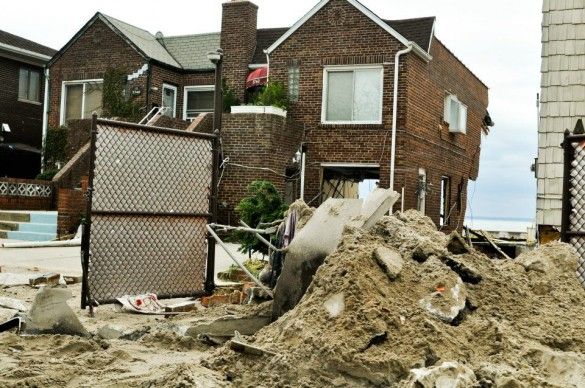Report: Coney Island Still Trashed After Sandy

Damaged schools, health facilities, libraries, abandoned storefronts and treacherous sinkholes. These are some of the major problems still afflicting Coney Island since Superstorm Sandy thrashed the area over eight months ago. Gotham Gazette is reporting that all the damage hasn’t come close to being repaired and that local residents are at their wits’ end in trying to live with them.
On Bensonhurst Bean, we have covered some of the frustration plaguing Coney Island locals. City Council candidate Mark Treyger was furious over the conditions at Carey Gardens (2955 West 24th Street), a New York City housing complex suffering from leaking roofs, the loss of its community center, a broken playground and the sinkhole problems on Neptune Avenue that could attract West Nile mosquitoes.
In another report, we tracked other frustrations facing Coney residents, namely the surging popularity of the pristinely restored beach area that has caused an uptick in traffic and congestion in the area. The restoration of the beach, Luna Park and other fun spots has been a sore spot for locals not buying the reports that Coney Island has fully rebounded:
“They say Coney Island is open for business. Sure, the entertainment district is, but no one talks about the parts of Coney Island where people actually live. They don’t talk about the neighborhoods,” said Ed Cosme, a resident who formed The People’s Coalition of Coney Island to raise awareness about the problems in the parts of the neighborhood that don’t normally draw tourists and bathers.
The Gotham Gazette described the state of a massive sinkhole present on Neptune Avenue:
On Neptune Avenue in Coney Island, state Sen. Diane Savino and a group of community activists walked a cracked and broken sidewalk on a recent day this summer — taking a tour of damage that remains nearly a year after Hurricane Sandy pummeled some of the city’s notable coastal neighborhoods.
At one point, the group stopped to look past a contorted chain-link fence at a massive sinkhole filled with bags of trash, milk cartons and diapers. The crevasse yawned with fault lines that zigged and zagged onto the sidewalk and towards the street. It looked to be growing.
“That thing goes down a ways,” said Ken Jones, a longtime community activist, referring to the sinkhole. “It’s probably right under the sidewalk.” The fact that it has apparently been used on more than one occasion as a dump only added to the activists’ concern that no one — not the state, not the city — is paying enough attention to their neighborhood…
Councilman Domenic Recchia, whose district includes Coney Island, said he has been in contact with multiple city agencies that are working together to study the sinkhole problem in particular.
“They are trying to find out why we are having this problem,” Recchia said. “It isn’t clear if the earth is moving or the sand got pushed out from under the pavement by the flood. But I know it is a problem for a lot of people. They are getting them in their driveway or backyards. I get calls about it all the time.”
While the problems afflicting Coney residents are extensive, a small measure of relief is coming in the form of a $6 million grant provided by Governor Andrew Cuomo’s New York Rising Community Reconstruction Program. The plan is unique in that it allows local community leaders and officials to decide the best way to spend the federal money allotted to them, removing the sometimes disconnected overreach of authorities with no sense of what’s going on the ground.
The report goes on to describe other problems facing the area, including abandoned storefronts, broken docks and lost community outreach programs:
But it isn’t just the sinkholes that have residents concerned that their part of Coney Island is being ignored. Looking past the massive sinkhole on Neptune Avenue, the tortured skeleton of a wooden dock uprooted and smashed by Hurricane Sandy could be seen. A number of boats remained lifted out of the water, stranded on rocks, water-damaged and rotting. “No one has claimed them yet?” Savino asked rhetorically.
The owners are likely long gone. Just like the proprietors of the closed Chinese food restaurant and bodega across the street. “They were just hanging on before Sandy,” Savino said. “They were already in debt. After that storm, another loan wasn’t going to save them.”
Aida Leon is the executive director of the Amethyst Women’s Project, a group that helps women struggling with substance abuse, domestic violence and HIV/AIDS.
As the tour of Coney Island progressed, she said she was concerned that established charitable organizations had been ignored by the larger groups that came in with funding to address problems caused by Sandy.
“They haven’t been on the ground like we have,” she said. “We lost a lot of people after Sandy. They didn’t come back to the programs and I don’t think they are coming back because the people with funding don’t know how to reach them.”
Councilman Domenic Recchia tried to find bright spots in the otherwise bleak picture, claiming that the New York City Housing Authority (NYCHA) was out fixing the sinkholes and that not all of the community programs were gone.
“We have summer programs like the Cornerstone program and others out of Kaiser Park. They may not all be open but there are programs,” Recchia told the Gotham Gazette.”Compared to other parts of the city, I think we’re doing pretty good. Take a look at the NYCHA facilities — they are working on them. It’s not like the work isn’t happening.”




